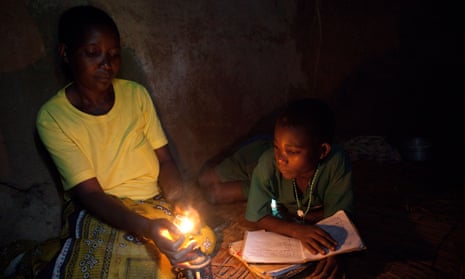At the Paris climate talks last December, governments agreed to work towards limiting global warming to 1.5C above pre-industrial levels. But the topic of financing developing countries to help them adapt to climate change and transition to clean energy became a sticking point during the negotiations.
We recently brought together a panel of experts to debate how developing countries can reach 100% renewables. Here’s what we learned:
1 Off-grid renewables are becoming more accessible
The falling cost of technologies such as solar PV means renewables have become cost-effective in many parts of the developing world, said Henning Wuester, director of the International Renewable Energy Agency’s Knowledge, Policy and Finance Centre. This is particularly the case in rural areas away from the electricity grid, where people are otherwise using relatively expensive, inefficient diesel generators and kerosene lamps.
Despite this, the upfront cost of small-scale solar systems to power a few lights or charge a mobile phone can present a significant barrier to widespread adoption, said Aly-Khan Jamal, a partner at Dalberg Global Development Advisors. However, he said there have been “exciting breakthroughs” in addressing such challenges:
Businesses providing these systems are using pay-as-you-go approaches that allow households and businesses to pay a small amount each month. Some allow you to eventually buy and fully own the system; others have a ‘perpetual lease’ where it is somewhat like paying for a utility.
2 Mobile money is critical ...
Mobile money payment systems make these pay-as-you-go models feasible, said Jamal, as they give businesses the ability to monitor and control electricity provision remotely, and make collecting payments very efficient – in turn significantly reducing costs.
Wuester added:
Mobile payment schemes have been critical in driving the roll-out of off-grid solutions. This has enabled more than 300,000 households [across East Africa] to get access to electricity, including about 30% of the Kenyan population, 40,000 in Uganda and 20,000 in Tanzania. These numbers are growing rapidly.
Maite Pina, renewable energy specialist at social investor Oikocredit International, gave the example of M-Pesa, a mobile money transfer system introduced in Kenya in 2007. Seven in 10 adults in Kenya now use the cash alternative, making 9m transactions daily. Pina said that Oikocredit – together with London-based solar systems provider BBoxx – uses M-Pesa to collect monthly payments from solar system users in sub-Saharan Africa.
3 ... but it has limits
Jamal pointed out, however, that mobile money penetration isn’t even across all countries, so different approaches need to be used depending on the market. What’s more, he added:
In the most remote and low income communities, mobile networks don’t invest in telecoms infrastructure (it’s not worth it for them) so relying on mobile money to reach these really challenging communities may not be sufficient.
4 Pay-as-you-go could trap the poorest in debt
Social entrepreneur and investor Jamie Hartzell put the following question to the panel:
The boom in pay-as-you-go household solar in East Africa is very exciting. But it is all based on credit, and the companies have a view to selling other products like TVs. How big is the risk that boom will turn to bust and push the poorest of the poor into unpayable debt?
Nico Tyabji, director of strategic partnerships at solar financier SunFunder, replied that while users might have a legally enforceable contract, “the reality is no one’s going to come knocking” – they just don’t get the service any more.
Tyabji said that since cutting off access isn’t in the companies’ interest, they spend time thinking about how to make the process work best, for example by setting up payment models around harvest season so that users can pay when they have access to money rather than having to stick to a regular payment schedule. However, he added that as products and services get bigger and pricier, Hartzell’s concerns could become an issue.
5 Credit must be responsible
Edward Hanrahan, CEO of ClimateCare, reiterated the need for caution in what he described as the “massive rush to [...] provide credit at levels unseen before to the lowest income populace”.
He cited the example of Pamoja Life, one of ClimateCare’s investment projects in east Africa, which ensures that the overall monthly or weekly cost of the goods provided is lower than the goods it is displacing (for example, a solar unit costs less than equivalent kerosene). This means monthly outgoings are reduced rather than increased.
Hanrahan added:
Of course, we are all now looking at providing ‘add-on’ products – fridges, internet access, TVs. It is crucial that we manage the ladder of credit in a very responsible manner
6 There’s a big investment gap
“The world is not investing enough in renewables as a whole, not just off-grid solar, given the imperatives of climate change and sustainable development goals,” said Jeremy Leggett, founder of Solarcentury and SolarAid, and chairman of Carbon Tracker.
While investment in large, centralised energy systems is driven mainly by multilateral agencies and large developers who rely on long term power purchase agreements, there is still a funding gap for decentralised systems where the requirements are smaller and the risks are higher, said Pina. Despite a growing interest in off-grid developments and new debt structures, Pina believes there is still a need to develop new guarantee structures to attract investors.
Tyabji said organisations such as SunFunder came into being to plug part of that investment gap:
With a few exceptions, we haven’t yet seen the levels of investment from development banks (let alone commercial banks) that other kinds of energy and infrastructure projects get. So it’s still down to niche players like us.

Comments (…)
Sign in or create your Guardian account to join the discussion